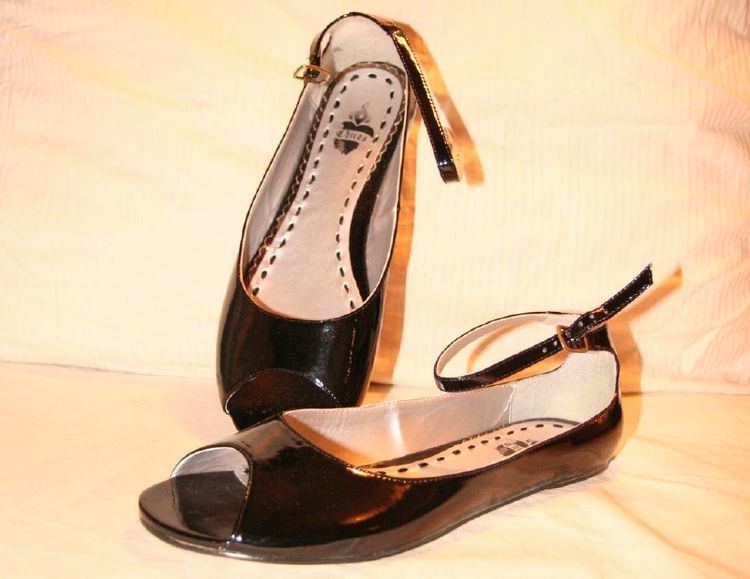 | ||
Patent leather is a type of coated leather that has a very glossy, shiny finish. The coating process was introduced to the United States and improved by inventor Seth Boyden of Newark, New Jersey in 1818, with commercial manufacture beginning September 20, 1819. Boyden's process, which he did not patent, used a linseed oil–based lacquer coating. Modern patent leather usually has a plastic coating.
Contents
History
In general, patent leather begins as a superior grade of fine grain leather that undergoes a process to achieve the glossy look. An early reference to patent leather is in the 1793 British periodical, The Bee, or Literary Weekly Intelligencer, which notes—in an article entitled "Hand's patent leather"—that "a gentleman of the name of Hand" in Birmingham, England obtained a patent for preparing flexible leather having a glaze and polish that renders it impervious to water and need only be wiped with a sponge to restore it to its original luster. In November 1799, inventor Edmund Prior of Holborn, London, England received a patent for a method of painting and colouring all kinds of leather, and in January 1805, inventor Charles Mollersten of Hackney Wick received a patent for applying a chemical composition in the preparation of hides, skins, and leather to give "a beautiful gloss." However, patent leather primarily owes its popularity to Seth Boyden.
In 1818, Boyden received a piece of German manufactured patent leather (said to be a German military cap front) from a local carriage manufacturer and used that to investigate the possibility of creating a version of leather in the United States that was treated in such a way that the material would be decidedly more dressy than work boots and similar leather goods, but retained its desirable qualities of protection and durability. Reverse engineering the European patent leather, he ultimately discovered a way to produce his own patent leather. Using a formula that was based on a series of treatments using layers of linseed oil-based coats, the new shiny leather began commercial production on 20 September 1819. Boyden’s efforts resulted in the production of glossy leather that quickly caught on as a complement for formal dress. Ironically, Boyden never patented his inventive process.
A subsequent European method of manufacture was described in 1906 as follows:
In the preparation of enamelled leather, a foundation coat of lampblack mixed with linseed oil has been laid on the flesh side, since the infancy of the industry in Europe. Successive coats of this mixture are applied, the skin being allowed to dry and the surface ground down with pumice-stone" after each coat. Then the skins are blackened again with a fluid black mixed with turpentine, and hung up to dry again. After the skins have been allowed to settle, being laid in a pile for about a month's time, or longer if possible, the leather is tacked onto a frame and receives a brush coat of varnish. A baking follows in an oven of moderate heat. The temperature is gradually raised and the baking continued three days. Exposure to the sun for ten hours completes the process. Recently American manufacturers have been making patent leather from chrome-tanned skins. The product is quite different, as is also the process employed. The leather is softer, more flexible, and takes a less brilliant polish than that made from bark-tanned leather, but it is much less likely to crack and is more suitable for shoes than the brittle and inflexible leather made by the older process.
Later, the substitution of plastics (such as Parkesine) for multiple treatments with linseed oil allowed patent leather to be produced more cheaply. Eventually, synthetic resins further simplified the process and cut production costs even further, making mass production of patent leather possible.
In the UK fashion trends of the 1960s, shoes, boots and handbags were often made of patent leather or vinyl. Patent shoes were available in red, white, blue, hot pink, orange, green and yellow, as well and black and white.
Product
Characterized by a glass-like finish that catches the light, patent leather comes in all colors just like regular leather. In addition to the mirror-like finish, patent leather is also virtually waterproof, while still retaining a very flexible texture. The visual aspects of patent leather have made it a sought-after material for formal accessories.
Patent leather is sometimes confused with poromeric imitation leathers such as DuPont's Corfam and Kuraray's Clarino, which are artificial materials with a similar glossy appearance.
Patent leather and poromerics are cleaned in a similar way. Dirt adhering to the coating can be removed with a damp cloth, using a mild soap if needed. Minor scratches and scuff marks in the coating can be removed using one of several special-purpose patent leather and poromeric cleaners on the market. With wear and tear, patent leather will eventually lose its glossy finish, but will still be smoother than most other types of leather, looking almost rubbery.
Lighter color patent leather is prone to color migration. When a patent item is stored next to a colored item, the dye from the colored item can migrate into the patent leather. Storing patent leather items in a white dust bag will help prevent this.
Patent leather and poromerics are used in applications where an eye-catching glossy appearance is the most important consideration. Examples include fashion items such as wallets and handbags, dance and uniform shoes, kinky boots and professional wrestling boots, belts and trench coats. In recent years patent leather has become a popular material for limited-edition sneakers.
